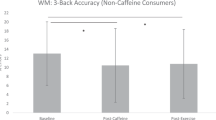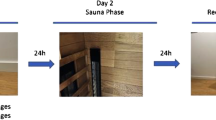Abstract
It is currently not known whether caffeine has an enhancing effect on long-term memory in humans. We used post-study caffeine administration to test its effect on memory consolidation using a behavioral discrimination task. Caffeine enhanced performance 24 h after administration according to an inverted U-shaped dose-response curve; this effect was specific to consolidation and not retrieval. We conclude that caffeine enhanced consolidation of long-term memories in humans.
This is a preview of subscription content, access via your institution
Access options
Subscribe to this journal
Receive 12 print issues and online access
$209.00 per year
only $17.42 per issue
Buy this article
- Purchase on Springer Link
- Instant access to full article PDF
Prices may be subject to local taxes which are calculated during checkout


Similar content being viewed by others
Change history
17 January 2014
In the version of this article initially published, in the first sentence in the Online Methods, the s.d. of the age of the subjects was missing and the number of female subjects was given as 280. The s.d. is 2 years and the number of female subjects is 80. The error has been corrected in the HTML and PDF versions of the article.
30 October 2014
In the version of this article initially published, there were errors in the reporting of statistics. In the Figure 1b legend, the asterisked P value was given in the HTML version as *P = 0.05 and in the PDF version as *P < 0.05. It should read *P < 0.05, one-tailed. In the Figure 2a legend, the degrees of freedom for the immediate caffeine group were given as 42 and the P value as 0.05; the correct values are 71 and 0.049, respectively. In the Figure 2b legend and the fifth paragraph of the main text, the P value for the main effect of caffeine was given as 0.001; the correct value is 0.05. The errors have been corrected in the HTML and PDF versions of the article.
References
Nehlig, A. J. Alzheimers Dis. 20 (suppl. 1) S85–S94 (2010).
McGaugh, J.L. Science 287, 248–251 (2000).
Yassa, M.A. & Stark, C.E.L. Trends Neurosci. 34, 515–525 (2011).
Yassa, M.A. et al. Hippocampus 21, 968–979 (2011).
Cunha, R.A. & Agostinho, P.M. J. Alzheimers Dis. 20 (suppl. 1) S95–S116 (2010).
Arendash, G.W. et al. Neuroscience 142, 941–952 (2006).
Sallaberry, C. et al. Neuropharmacology 64, 153–159 (2013).
Costa, M.S., Botton, P.H., Mioranzza, S., Souza, D.O. & Porciúncula, L.O. Neuroscience 153, 1071–1078 (2008).
Kopf, S.R., Melani, A., Pedata, F. & Pepeu, G. Psychopharmacology (Berl.) 146, 214–219 (1999).
Wright, G.A. et al. Science 339, 1202–1204 (2013).
Segal, S.K., Stark, S.M., Kattan, D., Stark, C.E. & Yassa, M.A. Neurobiol. Learn. Mem. 97, 465–469 (2012).
Ochiishi, T. et al. Neuroscience 93, 955–967 (1999).
Simons, S.B., Caruana, D.A., Zhao, M. & Dudek, S.M. Nat. Neurosci 15, 23–25 (2012).
Caruana, D.A., Alexander, G.M. & Dudek, S.M. Learn. Mem. 19, 391–400 (2012).
Restivo, L., Vetere, G., Bontempi, B. & Ammassari-Teule, M. J. Neurosci. 29, 8206–8214 (2009).
Tse, D. et al. Science 333, 891–895 (2011).
McGaugh, J.L. Annu. Rev. Neurosci. 27, 1–28 (2004).
Huff, M.L., Miller, R.L., Deisseroth, K., Moorman, D.E. & LaLumiere, R.T. Proc. Natl. Acad. Sci. USA 110, 3597–3602 (2013).
Shohamy, D. & Adcock, R.A. Trends Cogn. Sci. 14, 464–472 (2010).
Shohet, K.L. & Landrum, R.E. Psychol. Rep. 89, 521–526 (2001).
Shapiro, M. & Olton, D. Mem. Syst. 1994, 87–117 (1994).
McClelland, J.L., McNaughton, B.L. & O'Reilly, R.C. Psychol. Rev. 102, 419–457 (1995).
O'Reilly, R.C. & Norman, K.A. Trends Cogn. Sci. 6, 505–510 (2002).
Perera, V., Gross, A.S. & McLachlan, A.J. Biomed. Chromatogr. 24, 1136–1144 (2010).
Acknowledgements
M.A.Y. is supported by US National Institute on Aging P50 AG05146 and R01 AG034613. J.P.T. is supported by US National Science Foundation CHE-1213438. D.B. is supported by a Johns Hopkins University Provost Undergraduate Research Award. We thank A. Newman and C. Townsend for the use of their high-performance liquid chromatography instrument, D. Spira, A. Ward and J. Kim for help with participant testing, Z. Reagh for help with data analysis, and J. Knierim for helpful discussions regarding this manuscript.
Author information
Authors and Affiliations
Contributions
D.B., J.P.T. and M.A.Y. designed the study. D.B., E.M., G.K., A.C., J.M.W. and M.L. conducted the experiments. D.B. and M.A.Y. wrote the manuscript with input from all authors.
Corresponding author
Ethics declarations
Competing interests
The authors declare no competing financial interests.
Integrated supplementary information
Supplementary Figure 1 Representative high-performance liquid chromatography (HPLC) trace.
Trace shows distinct peaks for caffeine, paraxanthine and benzotriazole. Units are in milli Absorbance Units (mAU) at 280 nm.
Supplementary Figure 2 Caffeine absorption and metabolism.
Group averages of the sum of caffeine and paraxanthine concentrations (μg/ml) from HPLC. Both the caffeine and placebo group had negligible amounts of caffeine and paraxanthine in saliva at baseline. The caffeine group had a significant increase in caffeine and paraxanthine concentrations at 1 hour and 3 hours, then declined to baseline at 24 hours. The placebo group had no such increase in caffeine or paraxanthine. Error bars are + 1 s.e.m.
Supplementary information
Supplementary Text and Figures
Supplementary Figures 1–2 and Supplementary Table 1 (PDF 212 kb)
Rights and permissions
About this article
Cite this article
Borota, D., Murray, E., Keceli, G. et al. Post-study caffeine administration enhances memory consolidation in humans. Nat Neurosci 17, 201–203 (2014). https://doi.org/10.1038/nn.3623
Received:
Accepted:
Published:
Issue Date:
DOI: https://doi.org/10.1038/nn.3623
This article is cited by
-
The effects of passive and active administration of heroin, and associated conditioned stimuli, on consolidation of object memory
Scientific Reports (2022)
-
Augmenting cognitive work: a review of cognitive enhancement methods and applications for operational domains
Cognition, Technology & Work (2022)
-
Habitual coffee drinkers display a distinct pattern of brain functional connectivity
Molecular Psychiatry (2021)
-
Experimental study of pre- and postnatal caffeine exposure and its observable effects on selected neurotransmitters and behavioural attributes at puberty
Metabolic Brain Disease (2021)
-
The effect of acute aerobic exercise on the consolidation of motor memories
Experimental Brain Research (2021)



